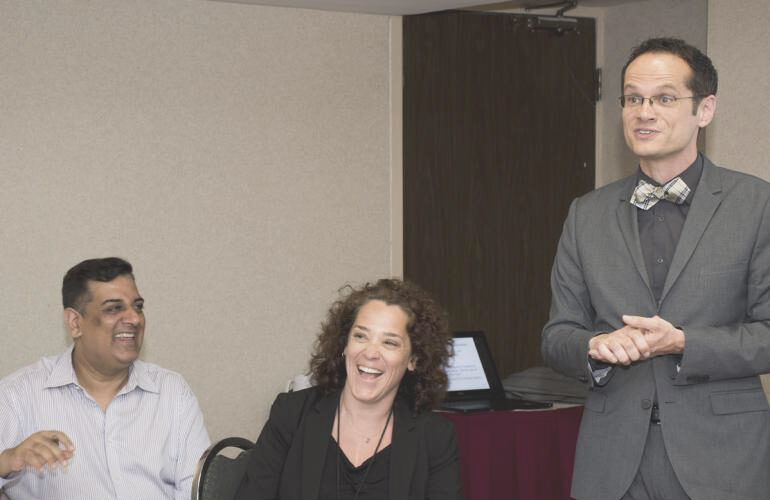During diTHINK, nearly 200 attendees representing Ontario’s research, education and innovation industry gathered to engage in the kind of conversations that can help move Ontario’s innovation economy forward. From customized learning to connected communities to advanced computing, here’s what we learned.
Featuring Compute Ontario board chair, Mark Daley, and Compute Ontario President and CEO, Nizar Ladak, this breakout explored the direction of provincial advanced computing capabilities – from coordinated efforts to taking Ontario’s talent to a level of global competitiveness.
It is undeniable: high-performance computing is on the rise. Nizar pointed out that demand is outpacing supply. In response, Compute Ontario is building its strategic plan, which includes looking for ways to better engage with the province’s advanced computing community. Compute Ontario is a federated organization, which means it draws upon the high performance computing consortia and its partners. As the board chair of Compute Ontario, Mark Daley resolved to build upon the excellence that we already have in place in Ontario. “Our job is to recognize excellence and protect excellence,” he said.
Furthermore, Mark and Nizar discussed the pattern that Ontario’s highly qualified personnel (HQPs) are being picked up by tech companies like Google and Amazon. The reason? Nizar identified that HQPs are leaving because they can’t get access to the tools they need at home. “There are 100,000 Canadians in Silicon Valley, and we have the tech corridor here,” he remarked. In order to strengthen and retain Ontario’s HQPs, over the next five years, Compute Ontario will be connecting with Ontario’s advanced computing community for input.
The session concluded with lively Q and A with the audience. Some of the discussions included the capability to stream data, and the desire to support the needs of big data collection and processing. The question of industry engagement also arose, to which Nizar answered that Compute Ontario’s mandate cannot be fulfilled without developing partnerships with industry. Also, in order to link small companies and researchers, Mark pointed out that SOSCIP, a research and development consortium that pairs SMEs with academic researchers to use advanced computing resources, does good work in providing opportunities for collaboration.
Advanced computing research presentations
What’s happening on the ground in Ontario’s advanced computing research community? The second part of the diComputing session offered a preview into the myriad of projects occurring at universities across Ontario. In addition to the oral presentations below, poster presentations also offered further insight into the latest advanced computing research.
Top honours for the best poster presentation went to Ryerson University’s Kenneth Blahut for his ‘Mathematical Modelling of Hepatitis C Virus: Quantifying the Contribution of Cell-free versus Cell-to-cell Infection’. The winners of the best oral presentation were Wilfrid Laurier’s Robert Morouney, David Rusu, and Vaughan Hilts for their parallelization of the learning algorithm described in ‘A Monte-Carlo AIXI Approximation’.
Read more on Compute Ontario’s blog.
James Chow (University of Toronto) started the morning presentations by sharing his big data and cloud computing applications for evaluating international radiation treatment systems. His proposal is to build a large, web-based database from which researchers around the world can draw upon. Graham Taylor (University of Guelph) then took us into his deep learning analysis, where his team is using hardware accelerators to speed up deep learning algorithms. These accelerators include multi-graphics processing units (GPU) and field-programmable gate arrays (FPGAs). David Hilts, Morouney Rusu, and Robert Vaughan (Wilfred Laurier University) ended the morning talks by showing an alternative to AIXI, a mathematical solution in machine learning. They presented a new concept developed on the SHARCNET computing cluster: the Monte-Carlo AIXI which parallels AIXI but offers computing capabilities.
In the afternoon, Shimiao Zhang (McMaster University) demonstrated the precursor effects of the structure and properties of synthesized polymer networks using molecular dynamics – it turns out that given the choice of precursor, there is a major difference in spatial distribution of defects. In Jonathan Gillett (University of Ontario Institute of Technology)’s presentation, he elaborated upon the dynamics of Bitcoin, namely the peer-to-peer network of the blockchain. Erik Schnetter (Perimeter Institute for Theoretical Physics) concluded with his presentation about Julia programming language features, which are quite applicable in a high-performance computing environment.



